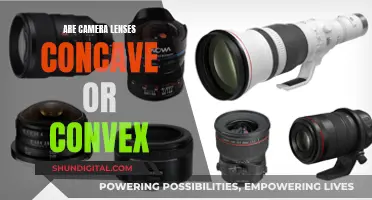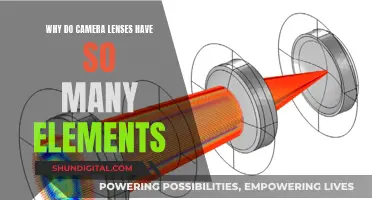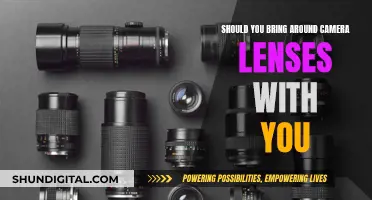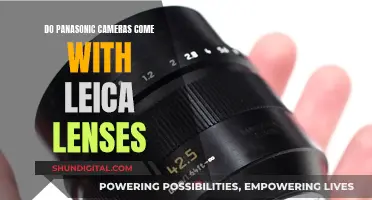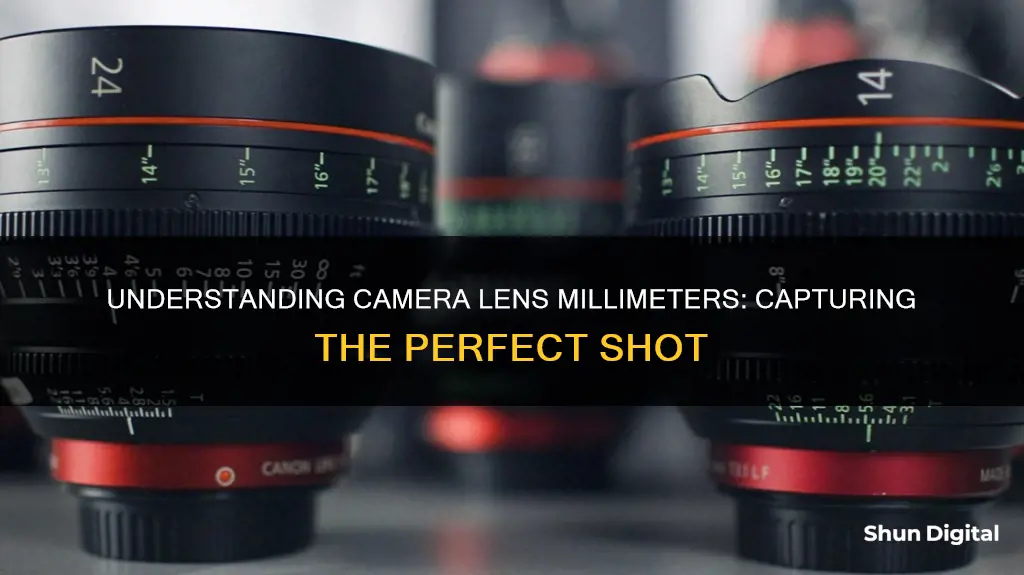
The 'mm' number on a camera lens is a measurement in millimetres of the focal length. This is the distance from the optical centre of the lens to the camera's sensor when focused on infinity. The focal length is what you see when you look through your camera viewfinder. The higher the focal length, the less you will see in your image and the more zoomed in it will be. A wide-angle lens has a short focal length, whereas a telephoto lens has a long focal length.
What You'll Learn
- Focal length: the distance from the lens centre to the image focal point
- Wide-angle lenses: have a short focal length, a wide angle of view, and a wider image
- Telephoto lenses: have a long focal length, a narrow angle of view, and a more zoomed-in image
- Focal range: the lower the focal length, the wider the range; the higher, the more zoomed in
- Magnification: the number of times an image is enlarged

Focal length: the distance from the lens centre to the image focal point
Focal length is the distance from the centre of a camera lens to the image focal point (or the image sensor surface). This distance is measured in millimetres (mm).
Focal length determines the lens's angle of view, which is the width of the field included in a photograph. A lens with a short focal length is a wide-angle lens, which has a wide angle of view. A lens with a long focal length is a telephoto lens, which has a narrow angle of view.
The focal length of a lens also determines how much of a scene a camera will capture, and at what magnification. A longer focal length will result in a narrower angle of view and higher magnification, while a shorter focal length will result in a wider angle of view and lower magnification.
The focal length of a lens is not the same as the physical length of the lens. The focal length is an optical distance, calculated from the point where light rays converge to form a sharp image of an object, to the digital sensor or 35mm film at the focal plane in the camera. The focal length is determined when the lens is focused at infinity.
Filters for Capturing Cinematic Shots with Your Camera Lenses
You may want to see also

Wide-angle lenses: have a short focal length, a wide angle of view, and a wider image
A wide-angle lens is a lens with a short focal length, a wide angle of view, and a wider image. The focal length of a lens is the distance from the centre of the lens to the image focal point, which is the same as the image sensor surface. This distance is measured in millimetres (mm). A lens with a short focal length is a wide-angle lens, and a lens with a long focal length is a telephoto lens.
The angle of view is the angle indicating the width of the field included in the photo. A wide-angle lens has a wider angle of view than a telephoto lens. The wider angle of view of a wide-angle lens allows more of a scene to be included in a photograph. This is useful in architectural, interior, and landscape photography, where the photographer may not be able to move farther from the scene to photograph it. Wide-angle lenses are also used to emphasise the difference in size or distance between objects in the foreground and the background. Nearby objects appear very large, while objects at a moderate distance appear small and far away. This exaggeration of relative size can be used to make foreground objects more prominent and striking, while still capturing expansive backgrounds.
The focal length of a lens is also related to its magnification properties. Wide-angle lenses have a shorter focal length, and are good for taking in a broad span of a landscape, from near to far. They are good when you want to take in more of a scene. Telephoto lenses have a longer focal length and are good for bringing wildlife up close while allowing you to maintain a distance from the subject. Longer focal lengths are also good for portraits and sports photography.
The focal length of a lens is affected by the size of the camera's image sensor. All lenses are measured off the full-frame sensor. If you have an APS-C camera or micro 4/3, these cameras have smaller sensors, so check the crop factor. It could be 1.5x for Nikon DX, Sony, Pentax, Fuji, 1.6x for Canon, or 2.0x for micro 4/3. To find the effective focal length, take the mm of the lens multiplied by the crop factor. For example, a 28mm lens with a crop factor of 1.5 would have an effective focal length of 42mm.
Understanding Camera Lenses: Describing the Basics
You may want to see also

Telephoto lenses: have a long focal length, a narrow angle of view, and a more zoomed-in image
A telephoto lens is a type of long-focus lens used in photography and cinematography. It makes far-away objects appear closer to the camera, and is commonly used in wildlife photography.
Telephoto lenses have a focal length longer than the diagonal size of the image they produce. This can be any length over 50mm, though some say a telephoto lens starts at 70mm or even 80mm. The longer the focal length, the more pieces of glass are needed inside the lens, making it larger, heavier and more expensive.
Telephoto lenses have a narrow angle of view, which falls somewhere between 1 and 30 degrees. This means they capture a smaller part of a scene than the camera sensor could detect, and the image must be stretched to fill the frame. This can cause pincushion distortion, where distances in the image appear shorter, and is particularly noticeable in cameras with bigger full-frame sensors.
Telephoto lenses are often divided into subtypes: short or portrait (85-135mm), medium (135-300mm) and super (over 300mm).
Understanding Camera Lenses: Magnification Options for Photographers
You may want to see also

Focal range: the lower the focal length, the wider the range; the higher, the more zoomed in
The numbers printed on a camera lens refer to the focal length, measured in millimeters. This is the distance from the optical centre of the lens to the camera's sensor when focused on infinity. This measurement is usually expressed as a single number, but can also be a range, as in the case of zoom lenses.
A lens with a short focal length is a wide-angle lens, and one with a long focal length is a telephoto lens. The focal length determines the angle of view, or how much of the scene the camera will capture. A wide-angle lens has a wider angle of view, while a telephoto lens has a narrower angle of view.
The lower the focal length, the wider the range of the image. This means that a lower focal length will allow you to see more in your image. Lenses with a focal length under 50mm are good for capturing landscapes, as they can take in the broad span of the scene, from near to far.
The higher the focal length, the more zoomed in the image will be. This means that a higher focal length will allow you to see less in your image, but at a closer range. Lenses with a focal length over 50mm are good for bringing wildlife up close, as well as for portraits and sports.
It's important to note that the focal length of a lens is also affected by the size of the camera's image sensor. All lenses are measured off the full-frame sensor, but if you have a camera with a smaller sensor, such as an APS-C or micro 4/3, you'll need to consider the crop factor. This will impact the effective focal length of your lens.
Flat Pancake Camera Lenses: How Do They Work?
You may want to see also

Magnification: the number of times an image is enlarged
The 'mm' number on a camera lens refers to the focal length, which is the distance from the optical centre of the lens to the camera's sensor when focused on infinity. This focal length is measured in millimetres and determines how much of a scene the camera will capture.
Magnification is the process of enlarging an image, making an object appear larger than it is. This is achieved by using a lens with a shorter focal length (under 50mm), which is known as a wide-angle lens. These lenses are good for capturing a broad span of a landscape, for instance, as they allow you to take in more of a scene.
A lens with a longer focal length (over 50mm) is known as a telephoto lens. These lenses bring the subject closer, allowing you to see finer details, but they do not capture as much of the surrounding scene. This is useful for wildlife photography, as it allows you to observe animals from a distance. Longer focal lengths are also commonly used for portraits and sports photography.
The magnification of a lens is also influenced by the size of the camera's image sensor. Lenses are measured based on a full-frame sensor, so if your camera has a smaller sensor, you will need to adjust the focal length accordingly.
By understanding the relationship between focal length and magnification, photographers can choose the right lens for their desired shot, whether it's capturing a vast landscape or bringing distant subjects closer.
Camera Lenses: Understanding the Basics of Photography
You may want to see also
Frequently asked questions
"Mm" stands for millimeter, which is the standard unit of measurement for the focal length of a lens.
Focal length refers to the distance from the centre of the lens to the image focal point (or image sensor surface). In simpler terms, it tells you how much of the scene your camera will be able to capture.
A wide-angle lens has a short focal length, meaning it can capture more of a scene from near to far. A telephoto lens has a long focal length, allowing you to bring subjects closer while maintaining distance from them.
A lower focal length (smaller number) provides a wider view, allowing you to see more in your image. Conversely, a higher focal length (larger number) results in a more zoomed-in image, capturing less of the scene.


